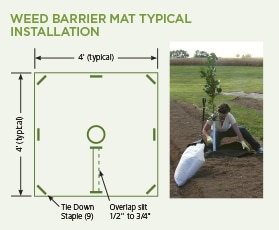Give your new trees the best start
The best projects begin with the best trees. Our RPM (Root Production Method®) gives our native plants a distinct advantage. RPM is all-natural method that yields twice the results in half the time. Studies show our RPM-produced plants grow, flower and fruit two times faster. Faster growth comes in part from unsurpassed lateral root mass.
Our RPM-produced plants also survive like champs. More than 95% survivability on the toughest sites. And, then there’s our proprietary soil media. It unlocks your plants’ ability to access nutrients, so they continue to thrive. Even through the life of the plant!

We developed a planting system called Walk-A-Way that further supports project success. It incorporates 10 key steps.
1. Forrest Keeling’s RPM-produced plants use seed provenance. Provenance tells the plant when to break dormancy. It also helps ensure consistent flowering and fruiting at your planting sites. We travel to different parts of the country to collect seed. Then, we code seedlings by region for the best performance in their final planting sites.
2. Planting in raised, flat planting beds helps with site maintenance. The bed should be eight to 10 inches in height and seven feet wide at the base. Compact the bed’s soil with two passes of a two-gang roller with weight of 200 pounds per foot.
3. A companion crop between trees reduces competition from woody and herbaceous vegetation. A seed mix of Red Top (Agrostis alba) at 4 pounds per acre; and Kentucky Bluegrass (Poa pratensis) at 4 pounds per acre works well. You could also do a solid planting of Red Top at six pounds/acre. For best results, seed in fall between August 10 and September 20. You could also do a dormant winter seeding during January–February or in spring.
4. Apply slow-release fertilizer in late fall or early winter while trees are dormant. Our choice is one like Everris 27-3-6 with IBDU (isobutylidene diurea). A 50-lb. bag will treat 500 trees with 3’ circumference application.
5. Fall tree planting is best, or early spring.
6. Planting pits should be dug on tops of berms. Pits should be about the same size as the plant container with vertical sides and a flat bottom.
7. Our tree guard system protects and allows for growth. A white, recycled 24-30” length of PVC wraps around the tree’s trunk. The guard will prevent damage from deer, rabbits, rodents… even weed whips and mowers!
8. Use RPM plant stock with well-branched, air root-pruned root systems. For best results, use stock 1/2 inch in caliper and 3–5’ in average height. Plant containers at least 10 inches in diameter and 7.5 inches in depth. Soil media should have 30% air space or more.
9. Reduce weeds with a barrier mat. Our favorite is a thin, water-permeable, 4’ X 4’ photodegradable polypropylene. Secured with landscape staples, the mat will last several seasons. On sites where mat is impractical, hardwood mulch is easy and affordable.
10. Spacing 20–30’ apart with adjacent rows staggered reduces competition between trees. Plant hard mast trees 30’ apart to create a full canopy in approximately 20 years. This equates to about 49 trees per acre.


